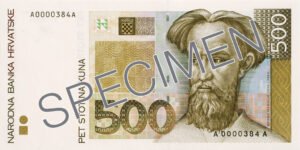The local currency of Croatia is the Euro which was officially adopted as the national currency on January 1, 2023. The adoption of the Euro made Croatia the twentieth member state of the eurozone. It was also accompanied by the country’s entry into the Schengen Area, making Croatia fully integrated into the European Union’s economic and financial systems.
A fixed conversion rate between Croatia’s previous currency, the Croatian kuna and the Euro was set at 1€ = 7,5345 HRK. January 15, 2023 was the last day on which kuna was used in payments, after which the old kuna notes and coins (called lipe) are only to be exchanged by the Croatian National Bank (three years for coins and indefinitely for banknotes).
* * *
About the abolished Kuna currency


The term kuna denoting the former Croatian currency originated from the Croatian word for a marten, whose pelts were historically used both as a form of tax-paying and as a trading commodity in the marketplaces of medieval Croatia. The word lipa, denoting the smaller value coins equivalent to the cent, stands for the linden tree, a botanic species traditionally thought to have a special place in the ancient mythologies of the ancient Slavs. The same term is also at the root of the Croatian name for the month of June – lipanj: a month when the linden trees blossom.
Kuna itself was only introduced as a currency of Croatia in May 1994, as a replacement for the short-lived Croatian dinar introduced following the declaration of Croatian independence from Yugoslavia in December 1991.
Croatian kunas were available in the form of bank notes and in coins. The banknotes were printed in denominations of 10, 20, 50, 100, 200, 500 and 1000 kunas respectively. The obverses of the banknotes were designed to depict portraits of historically important individuals, mostly politicians and a few writers, while the reverses feature architectural landmarks and historical artifacts associated with some of the Croatia’s largest cities. The city of Split was featured on the 500 kuna banknote that was adorned with the portrait of the Split-born renaissance writer and thinker Marko Marulić (Marcus Marulus Spalatensis), whose statute still stands on the Fruit Square (Voćni trg), on the obverse, with the reverse featuring a rendering of the Diocletian’s palace paired together with the eleventh-century motif of the so-called Croatian ruler from the Baptistery of St John.
The coins that were in circulation held the denominations of 1, 2, and 5 kunas; and 5, 10, 20 and 50 lipas. Though coins denoting 1 and 2 lipa, and 25 kuna also exist, they are very rarely found in the day-to-day circulation, with the latter being a collector’s item commemorating various historically important anniversaries and events.
Debit and credit cards
Generally paying with a debit or credit card is a bit of a mixed experience. Although most, if not all, supermarkets, shops and pharmacies accept payment by card, the situation is less straightforward when dealing with restaurants, bars and cafés. Generally restaurants in Split are more likely to accept credit cards, but bars and cafés are less inclined to do so. If you are planning on travelling to the islands or in the rural hinterland, it is even less likely to find businesses that accept debit or credit cards, hence it is advisable that you always carry a bit of cash at hand, to avoid potential problems with payments.
Generally, we recommend that you use your card at places that accept them, and your cash in places that don’t.
Tipping
Tipping in Croatia isn’t obligatory, though it has grown to be expected in recent years. The majority of places will not have a ‘tip included’ portion in the bill, so you will be left to tip at your own discretion.
Unlike some countries, like the US, the service staff like the waiters, for example, are not kept on minimum wage, hence tipping is a bonus not a necessity.
Since restaurants are the establishments that deal with tourists the most, service there has gone to expect the highest tips. We recommend that you tip according to the service you received and that you do not hesitate to not tip at all if you find the service dreadful. Typically, any tip is appreciated, though the 10 percent tip is always most welcomed.
In bars and cafes tipping culture is a bit different, and it usually consists of rounding off the bill to the nearest ’round number’, for example a 9,60 euros bill will usually be rounded off to 10 EUR, etc.

